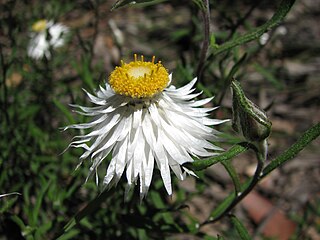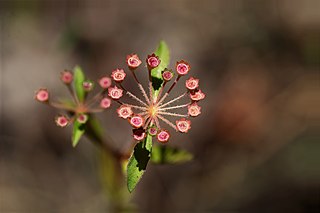
Aphanostephus (dozedaisy) is a genus of flowering plants in the family Asteraceae.
Oedera flavicoma is a species of flowering plant in the family Asteraceae. It is native to Cape Province in South Africa.

Arrowsmithia is a genus of flowering plants in the family Asteraceae.

Corethrogyne is a monotypic genus of flowering plant in the family Asteraceae. Its only species is Corethrogyne filaginifolia, known by the common names common sandaster and California aster.

Duhaldea is a genus of Asian flowering plants in the daisy family.
Moquinia is a genus of flowering plants in the tribe Moquinieae within the family Asteraceae.
Syncephalum is a genus of flowering plants in the pussy's-toes tribe within the family Asteraceae.
Blanchetia is a genus of flowering plants in the family Asteraceae, It is endemic to Brazil.

Chresta is a genus of South American flowering plants in the family Asteraceae.

Chronopappus is a genus of flowering plants in the family Asteraceae.

Helichrysum leucopsideum, commonly known as satin everlasting, is a flowering, perennial herb in the family Asteraceae. It is grows in all states of Australia except Queensland and the Northern Territory. It has white, terminal flower heads and narrow, woolly leaves.
Fraxinus berlandieriana, the Mexican ash, is a tree native to eastern and northeastern Mexico and to the south-central United States. It has been reported from Tamaulipas, Veracruz, Texas, New Mexico, Oklahoma, Louisiana and Mississippi.

Labramia is a genus of plants in the family Sapotaceae described as a genus in 1844. De Candolle initially named the genus Delastrea, which is a homonym for an older fungus name by Tulasne, so De Candolle changed the name to Labramia in the appendix to the same book.

Pomax is a genus of flowering plants in the coffee family, Rubiaceae. Pomax umbellata, found in Australia, is the sole species of the genus. The genus was created in 1830, by the Swiss taxonomist Augustin Pyramus de Candolle, and published in his Prodromus Systematis Naturalis Regni Vegetabilis. Pomax umbellata was first described as Opercularia umbellata by Joseph Gaertner in 1788. but was transferred to the genus, Pomax by Daniel Solander in 1834.

Scaevola glandulifera, the viscid hand-flower, is a shrub in the family Goodeniaceae, endemic to Western Australia.

Podolepis canescens is a herb in the Asteraceae family, which is found in South Australia, the Northern Territory, New South Wales and Victoria. PlantNet also states that it is found in Western Australia, but FloraBase states that the name is misapplied in Western Australia, based on Jeanes (2015).
Digitalis cariensis is a species of flowering plant in family Plantaginaceae. It is a type of foxglove. It is native to southwestern to southern Turkey.

Chrysocephalum baxteri, known by the common name fringed everlasting is a perennial herb native to southern Australia. It is a member of the Asteraceae, the daisy family. Found in low heath country and sclerophyll forest. A small plant, 10 to 40 cm high with many stems. Leaves are linear in shape, 4 to 30 mm long, 0.5 to 2.5 mm wide. Both leaf surfaces are a felty grey/green. White flowers mostly form in spring and summer.

Olearia cydoniifolia is a species of flowering plant in the family Asteraceae and is endemic to eastern Australia. It is a shrub with scattered elliptic leaves, and white and yellow, daisy-like inflorescences.

Andersonia gracilis is a species of flowering plant in the family Ericaceae and is endemic to the southwest of Western Australia. It is a slender erect or open straggly shrub with more or less lance-shaped leaves and groups of two to ten densely bearded, white or pinkish-purple, tube-shaped flowers.














